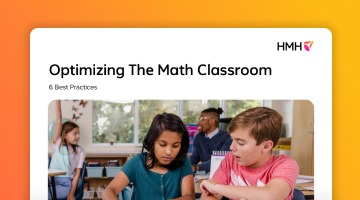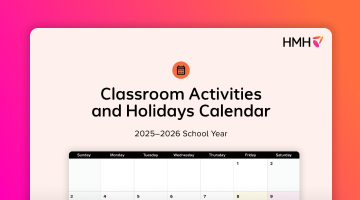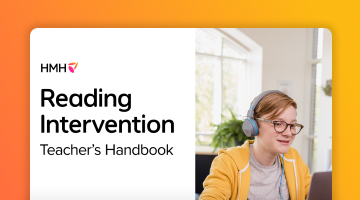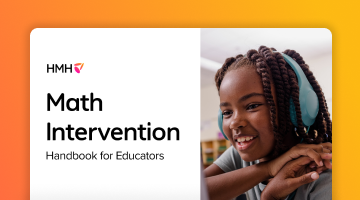
In recent years, the science of reading has grown as an important topic in conversations about literacy. It has sparked interest among educators seeking to provide their students with the best possible reading instruction. Let’s take a look at some of the key points of this important topic.
Science of reading: Definition
The science of reading is an interdisciplinary body of research focused on how reading skills are developed. The science of reading is not a curriculum or program. Defining what the science of reading is and isn’t is an important step in understanding how to apply what it tells us about how the human brain learns to read.
Science of reading research
The research that has informed our understanding of how the brain processes written words spans decades and comes out of multiple fields, including developmental psychology, neuroscience, linguistics, and, of course, education. Science of reading research is grounded in theories like the simple view of reading, proposed by psychologists Philip Gough and William Tunmer in 1986, which established that skilled reading requires the ability to decode text and comprehend it. The results have helped researchers identify the cognitive processes involved in decoding and comprehension, the two fundamental components of reading, and have reinforced the importance of systematic and explicit instruction in key foundational skills. For an overview, see “The Science of Reading Explained.”
Science of reading pillars
The science of reading research focuses on a set of skills, often called pillars or components, that are essential for proficient reading. When addressed through systematic and explicit instruction, the science of reading pillars help students integrate word recognition and language comprehension to derive meaning from text.
What are the five components of the science of reading?
The groundbreaking 2000 report by the National Reading Panel was essential in indicating the following science of reading components as crucial for effective reading instruction:
- Phonemic awareness is the ability to hear, identify, and manipulate individual sounds in spoken words. Key skills include blending, segmenting, substituting, and deleting sounds in words. It is a subskill of phonological awareness, which refers to the ability to recognize the sounds of spoken language.
- Phonics refers to the relationship between letters (graphemes) and the sounds (phonemes) they represent. Key skills include recognizing letter-sound correspondences, blending sounds into words, and decoding.
- Fluency is the ability to read text smoothly, accurately, and with expression, which is necessary for comprehension. Key skills include reading at an appropriate speed and, for oral reading fluency, using proper phrasing.
- Vocabulary refers to knowing what words mean and how to say and use them correctly. Key skills include understanding the meaning of words, including multiple meanings, and the relationships between words. Vocabulary is an essential component of building background knowledge in reading.
- Comprehension is the ability to understand, interpret, and analyze text. Key skills include summarizing, identifying the main idea, making predictions, and drawing conclusions.
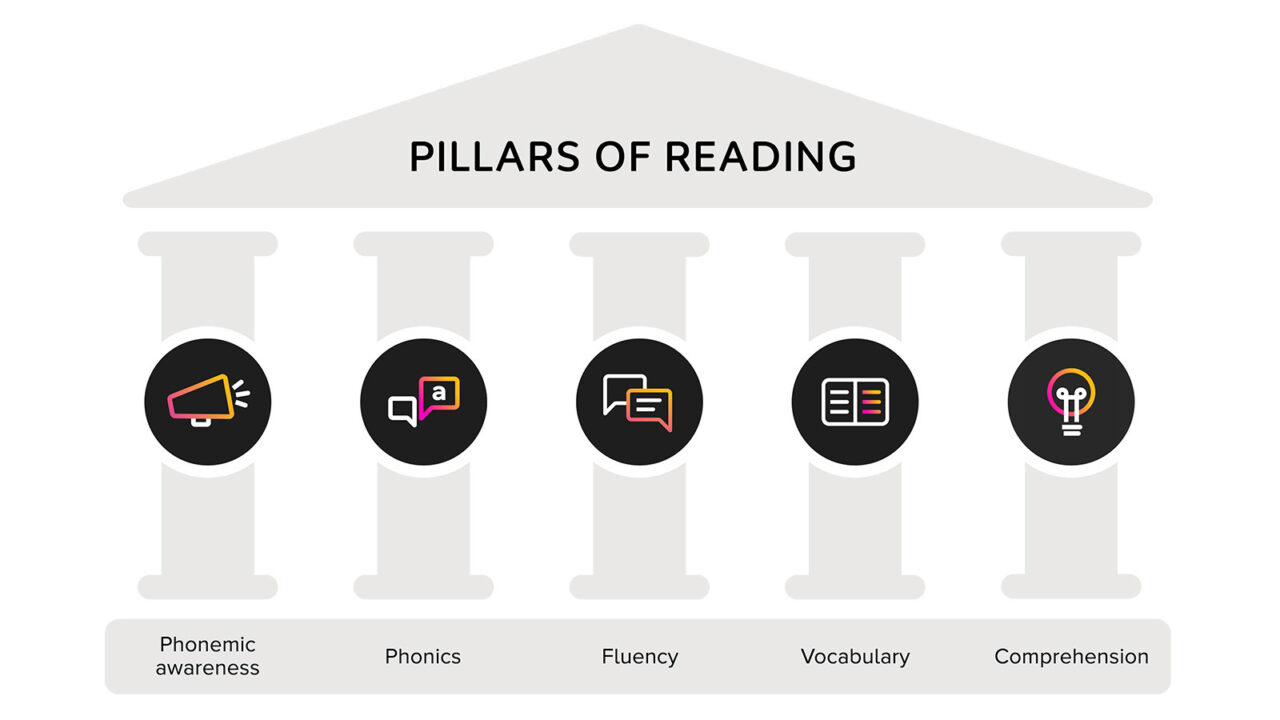
Scarborough’s Reading Rope
Scarborough’s Reading Rope is a visual framework for understanding how different strands of language comprehension and word recognition work together to lead to skilled reading. In this model, language comprehension includes background knowledge, vocabulary, language structures, verbal reasoning, and literacy knowledge. Word recognition includes phonological awareness, decoding, and sight recognition.
The rope metaphor highlights that fluent reading emerges from the integration of these interconnected skills, supporting the science of reading’s emphasis on instruction in both decoding and language comprehension skills.
Why is the science of reading important?
The science of reading is important because it provides the necessary research to align classroom instruction to what we know about how the human brain learns to read. By mapping teaching strategies to methods that have been proven effective through decades of research, reading instruction becomes more impactful.
The science of reading and dyslexia
Aligning reading instruction to research-based practices benefits all students and is especially effective in meeting the needs of students with dyslexia. The science of reading emphasizes explicit instruction in phonemic awareness, phonics, and word recognition—foundational skills that address the decoding and word recognition challenges that students with dyslexia face in reading accurately and fluently.
The science of reading and English language learners or multilingual learners (MLs)
Approaches grounded in the science of reading support MLs through explicit teaching of sound-symbol relationships, vocabulary development, and building background knowledge. These practices help MLs connect new language patterns to their growing literacy skills.
What the science of reading says about writing
Reading and writing draw on overlapping and complementary processes in the brain. Writing supports reading development by reinforcing phonics, vocabulary, and comprehension. Additionally, regular writing opportunities help students process and apply what they’ve learned in their reading. Learn more about the connections between the science of reading and writing in the article “How Does Writing Fit Into the Science of Reading?”
Misconceptions about the science of reading
There are numerous misconceptions about what the science of reading is and is not. To implement the science of reading in the classroom effectively, it’s essential to first address common misconceptions that can lead to misunderstandings. Here are four common misconceptions:
- It’s just phonics. This is perhaps the biggest misconception about the science of reading and likely comes from the fact that the research does indicate the importance of phonics. However, examining the pillars of the science of reading shows that phonics is one of several key components.
- It’s new. While buzz about the science of reading has increased in recent years, the research it draws from goes back decades and is ongoing.
- It’s a curriculum. The science of reading is not a curriculum, product, or program. It is the ongoing research that covers how humans learn to read. Various curricula use the science of reading as a research base, but it’s not a curriculum.
- It’s only for struggling readers. The science of reading is beneficial for struggling readers, but the principles of effective instruction apply to all students.
How to implement the science of reading in the classroom
Because the science of reading is a body of research, not an instructional approach in and of itself, it does not provide guidelines for how to teach the components it identifies as essential for learning to read. That’s where a well-designed science of reading curriculum comes in.
Selecting a science of reading curriculum
When evaluating programs, look for:
- Alignment with the five pillars of literacy
- Explicit, systematic foundational skills instruction
- An effective gradual release model
- Cross-curricular texts to build background knowledge and vocabulary
- Research-based writing instruction
Structured literacy vs. the science of reading
Structured literacy is a method for teaching foundational reading skills through explicit and systematic instruction. It can be thought of as the practical application of the science of reading. For a detailed comparison, see “Structured Literacy vs. Science of Reading.”
Science of reading strategies
The blog post “10 Science of Reading Strategies for Reading Instruction” provides step-by-step directions on implementing strategies aligned to each of the five components of the science of reading. See below for an overview of those strategies.
Phonemic awareness
- Word play: Can range from rhyming to manipulating phonemes
- Blend phonemes: Orally blending sounds to form words
Phonics
- Vowel valley activity: Involves explicitly teaching vowel sounds and mouth formations
- Decoding using sound-by-sound blending: Helps teach students to sound out words by each phoneme, moving left to right
Fluency
- Oral cloze read: Supports fluency and accuracy with continued readings
- Timed fluent reading: Encourages students to read quickly but also to comprehend
Vocabulary
- Generative vocabulary: Focuses on the morphology of words and supports students’ speaking, listening, and reading vocabularies across content areas
- Knowledge maps: Help build background knowledge on topics
Comprehension
- Making connections: Supports making connections to text based on students’ prior knowledge
- Synthesizing: Helps students gather important information from the story, make connections or inferences, and paraphrase to complete their understanding of a text
Additionally, science of reading sound walls can support phonemic awareness and phonics in the classroom. For even more ideas, check out our blogs on science of reading activities, science of reading small-group instructional strategies, and science of reading decoding strategies.
Science of reading professional development and teacher training
Professional learning is critical to ensure educators have the support they need to apply the science of reading effectively. Coaching, collaboration, and on-demand resources ensure alignment with research-based best practices. Learn more about science of reading professional development.
Science of reading resources
Whether it’s for a refresh or practical tips, science of reading resources provide a wealth of information. Check out these recommended science of reading books for ideas.
The importance of the science of reading lies in its ability to help align instructional approaches with decades of research on how the brain learns to read. By applying this knowledge through the science of reading, educators can ensure students acquire the foundational skills necessary to become proficient readers.
***
Dive deeper into the science of teaching reading. Learn more about our science of reading curriculum, an evidence-based approach that builds on the five components of the science of reading, plus integrates background knowledge and writing.
Get our free Science of Reading eBook today.


